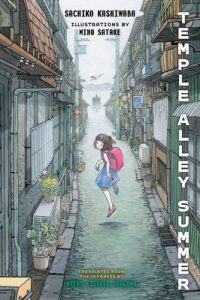 Temple Alley Summer
Temple Alley Summer
Written by Sachiko Kashiwaba
Illustrated by Miho Satake
Translated by Avery Fischer Udagawa
Restless Books, 2021, 232 pp
ISBN: 978-1632063038
This imaginative story is about a boy’s discovery of a ghost girl and their friendship. In the middle of the night, Kazu, a fifth-grader boy, sees a girl in a white kimono walking out of his family altar. The next day, Kazu is frightened to see her in his classroom. Her name is Akari, and her presence is normal to everybody else. Curious, Kazu investigates the mystery and discovers that his house was built on the site of a temple called Kimyo, which means ‘the dead coming back to life.’ Through the magic of the temple’s statue, Akari came back to life after her death 40 years ago. However, because the council of elders believe that the dead should not come back to life, she might die again. Kazu tries to protect the statue, which keeps Akari alive, while the elders want to destroy it. He also wants to do something meaningful for Akari to make her happy during the limited time she has left. Before Akari died, she had been reading a serial story in a magazine, and wants to read how the story ends before she passes away again. Kazu finds out that the magazine has been discontinued, and the story’s author is Minakami, a member of the council. Akari asks her to write the story, and then Minakami completes the story only for Akari.
This imaginative, suspenseful novel draws thoughtful questions of life and death in a different cultural context. Originally written in Japanese and translated into English, this book presents rich cultural aspects of Japan. Readers are introduced to different religious perspectives about life and death, mediated through Buddhist philosophy. This literary experience is valuable in developing open-mindedness to people whose cultural values and beliefs differ from their own. Readers in the U.S. predominantly adhere to Western ideas and ways of thinking. Dallmayr (2003) expresses concern that a universal belief system runs the risk of becoming hegemonic and imperialistic because it overlooks distinctions between different belief systems. According to Choo (2013), engaging in extraterritorial questioning effectively provides access to the consciousness and belief systems of another person or community, and literature is a powerful tool as an entry point into ethical, philosophical, and religious discussion.
This book recognizes the power of storytelling in another way. Using the magazine plotline, the author creates a story within a story, connecting Akari’s two different lives within the narrative. The embedded narrative, which is a Western tale about a European witch who loses her son, connects to the central narrative and broadens the cultural imagination of the novel’s audience. The publisher’s choice to print the embedded narrative in a different color of paper is an effective organizational and storytelling technique.
This book can be read alongside The Day of the Death – Día De Los Muertos, written by Hannah Eliot and illustrated by Jorge Gutierrez (2018), which portrays the traditional Mexican holiday when people honor their ancestors and loved ones who have passed by commemorating the cycle of life. When You Trap a Tiger, written by Tae Keller (2020), is another good book to pair with Temple Alley Summer. In this Newberry Award-winning book, Lily, a Korean American girl, discovers her inner strength and personal voice by embracing her grandmother’s history. Similarly to Kashiwaba, Keller uses an embedded narrative to address questions about life and death. This set of books will provide an opportunity in which readers can be introduced to philosophical thoughts about life and death in different cultures.
Sachiko Kashiwaba is a prolific Japanese writer of children’s and young adult fantasy. Her works have been loved for more than four decades. Her popular works, The Wonderland and The House of the Lost on the Cape (2023) have been animated for film. The Marvelous Village Veiled in Mist (2019) influenced Hayao Miyazaki’s film “Spirited Away”. She lives in Iwate, Japan.
Miho Satake, a Japanese artist and illustrator, contributed the cover art for Temple Alley Summer as well as illustrations within the book. She is best known for illustrating the Japanese editions of Howl’s Moving Castle (2004) and the twentieth-anniversary edition of the Harry Potter series.
This book is translated by Avery Udagawa. She grew up in Kansas and majored in English and Asian Studies. She holds an M.A. in Advanced Japanese Studies. She has studied abroad in Nagoya and Yokohama in Japan. She lives near Bangkok, Thailand with her bicultural family.
Temple Alley Summer is a winner of the Mildred L. Batchelder Award (2022) which is awarded to an American publisher for the most outstanding translated children’s book in English.
Reference
Choo, S. (2013). Reading the world, the globe, and the cosmos. Peter Lang.
Dallmayr, F. (2003). Cosmopolitanism: Moral and political. Political Theory, 31(3), 421-442.
HeeYoung Kim, West Texas A&M University
© 2023 by HeeYoung Kim

